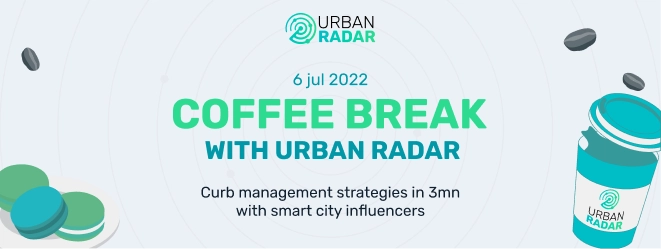What are we talking about today ?
- Competition for curb space, and how curb space is used, is changing significantly as demand from pedestrians, private vehicles, delivery vehicles, micromobilities and other users grows.
- Historically, most of the curb spaces were designed for private vehicles and parking, but often failed to satisfy the users.
- Rise of e-commerce and shared mobility solutions are shaping new needs. Covid-19 acted as an accelerator.
- Curb management is shifting from dull to dynamic, with cities using pilot programmes and technology to respond to the changing demand.
The city vew
A bold urban redesign taking place in Paris
In order to reconcile the new modes of mobility with automobile traffic and public transport, the city is planning to cut its car parking spaces by 50% by 2026. A bold move from Paris’ Mayor Hidalgo (who chaired C40, the global network of Mayors to confront the climate crisis in 2017-2018) illustrates the trend to rethink curb management in Europe and in the US.
The operator view
Amazon, UK
This week, Amazon launched its first micromobility hub in London from which fleets of cargo-bikes and walkers will make over five million deliveries a year across more than 10% of London’s Ultra Low Emission Zone. It will surely replace many vans but will create additional demand on the bike lanes, sidewalks and curbs.
The expert view
Urbike, Belgium
Aware that cities need support to accelerate the curb management transition, urbike in Belgium has developed new models to implement successful last mile delivery cargo-bike strategies. They combine strategic planning, designing pilot tests, to their cargo bike delivery operations with a team of professional couriers organised in a cooperative. As a reference player in the cyclo-logistics sector in Belgium, urbike assists both companies and local authorities in their logistical transition, such as the retailer Delhaize.

Urban Radar's takeway
Curb space and curb management form part of the last frontier when it comes to a city’s real estate. There are thousands of square kilometers that have historically received poor attention and sometimes even disdain. This is changing and it is fascinating.
Cars are no longer the first idea that comes to mind when we discuss curbs. The competing usage of curbs is leading to an upcoming battle between multiple potential users. A lot is at stake between shared mobility, deliveries, restaurant curblets, etc.
We see an increasing amount of attention from planners and cities shown to implementing new strategies. The american planning association is publishing its ‘Billion Dollars Curb’ series authored by Chrissy Mancini (t) .Their 7 steps curb-management frameworks includes: Set goals, identify land use, create a digital curb inventory, understand use, define strategy, launch a pilot program, develop a user friendly guide.
Several European cities are following similar steps to understand and optimize the use of their curbside spaces dedicated to last mile deliveries. With the financial support of EIT Urban Mobility (t) , and the joint public-private technical expertise of POLIS (t), Alice, Fit Consulting (t), CTAG, Carnet (t), and Urban Radar (t), the european cities of Funchal in Portugal, Leuven in Belgium, Strasbourg and Toulouse in France are embarking in the curb management journey. Led by Urban Radar (t), the curb management product Logistique Urbaine is being rolled out to:
Cars are no longer the first idea that comes to mind when we discuss curbs. The competing usage of curbs is leading to an upcoming battle between multiple potential users. A lot is at stake between shared mobility, deliveries, restaurant curblets, etc.
We see an increasing amount of attention from planners and cities shown to implementing new strategies. The american planning association is publishing its ‘Billion Dollars Curb’ series authored by Chrissy Mancini (t) .Their 7 steps curb-management frameworks includes: Set goals, identify land use, create a digital curb inventory, understand use, define strategy, launch a pilot program, develop a user friendly guide.
Several European cities are following similar steps to understand and optimize the use of their curbside spaces dedicated to last mile deliveries. With the financial support of EIT Urban Mobility (t) , and the joint public-private technical expertise of POLIS (t), Alice, Fit Consulting (t), CTAG, Carnet (t), and Urban Radar (t), the european cities of Funchal in Portugal, Leuven in Belgium, Strasbourg and Toulouse in France are embarking in the curb management journey. Led by Urban Radar (t), the curb management product Logistique Urbaine is being rolled out to:
- Create a complete digital inventory of loading zones and curbside regulations
- Understand the curb supply/demand visually and through analytics
- Adapt and communicate curb regulations to logistics providers
- Pilot and scale flexible loading zones
- Prepare for future loading zone booking solutions
We have exciting times ahead of us to prepare the ground for this transformation, cities can make use of digitization tools, piloting new programmes and learn from the implementation of new policies. If you’ve read the letter thus far, it means you have interest in curb management. We are identifying the nascent curb management community. Please register your interest here.
Additional readings
- Draft Flex Streets Parklet Guidelines for Public Review
- Food couriers parking on the sidewalks are getting on the nerves of Helsinki residents
- We’re working to improve curbside access in Seattle as part of a national effort to develop new digital tools and provide data-driven insights.
- Poor curb management is costing cities billions


